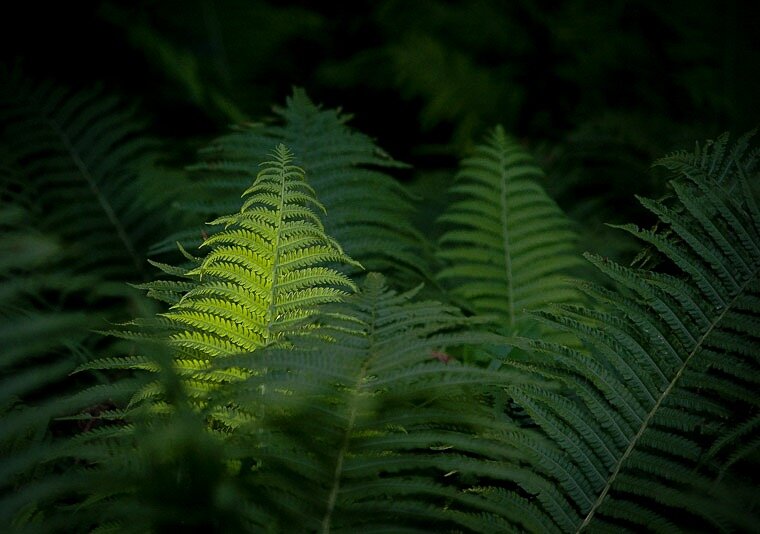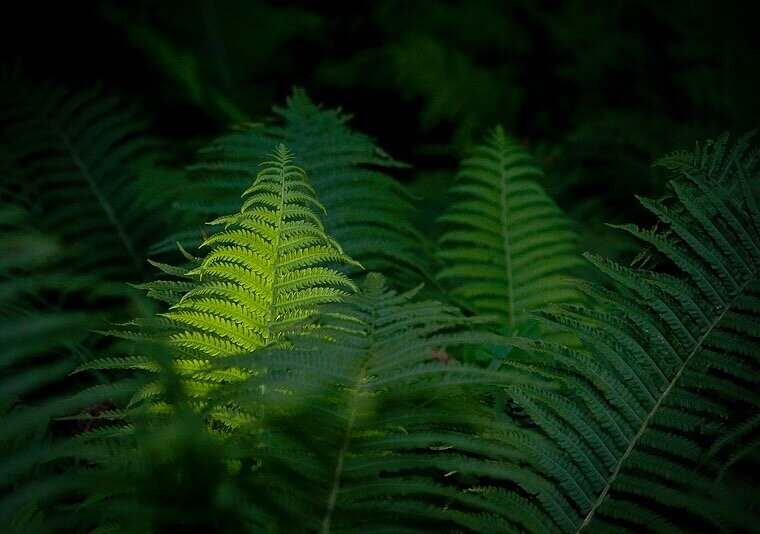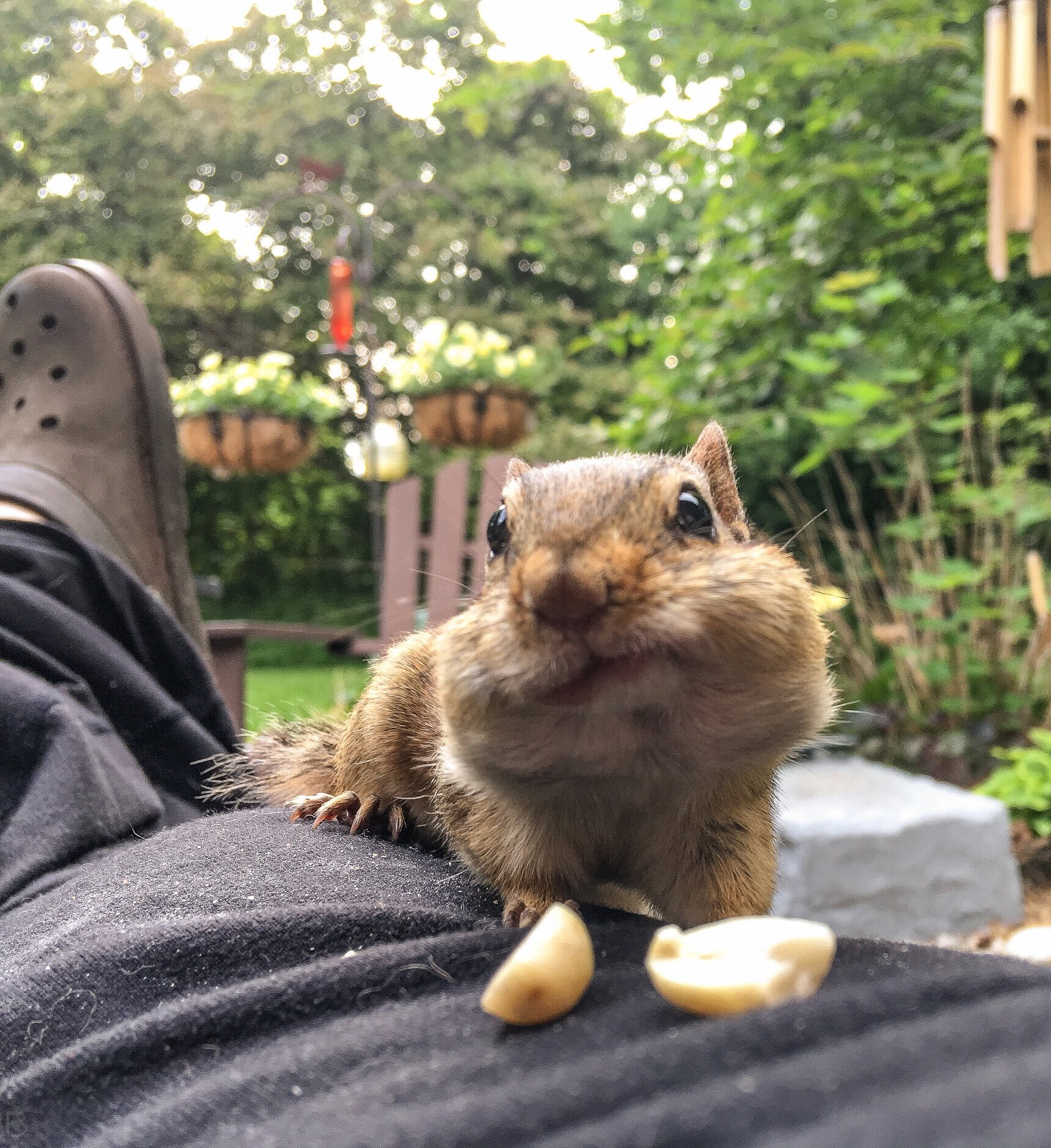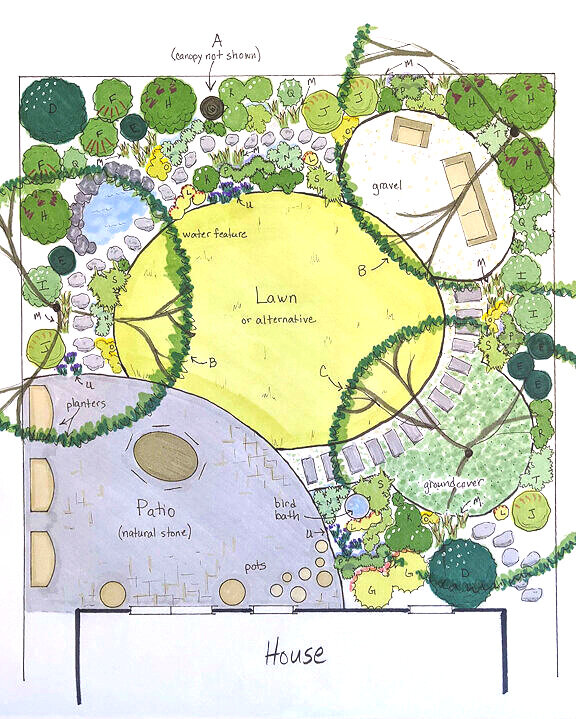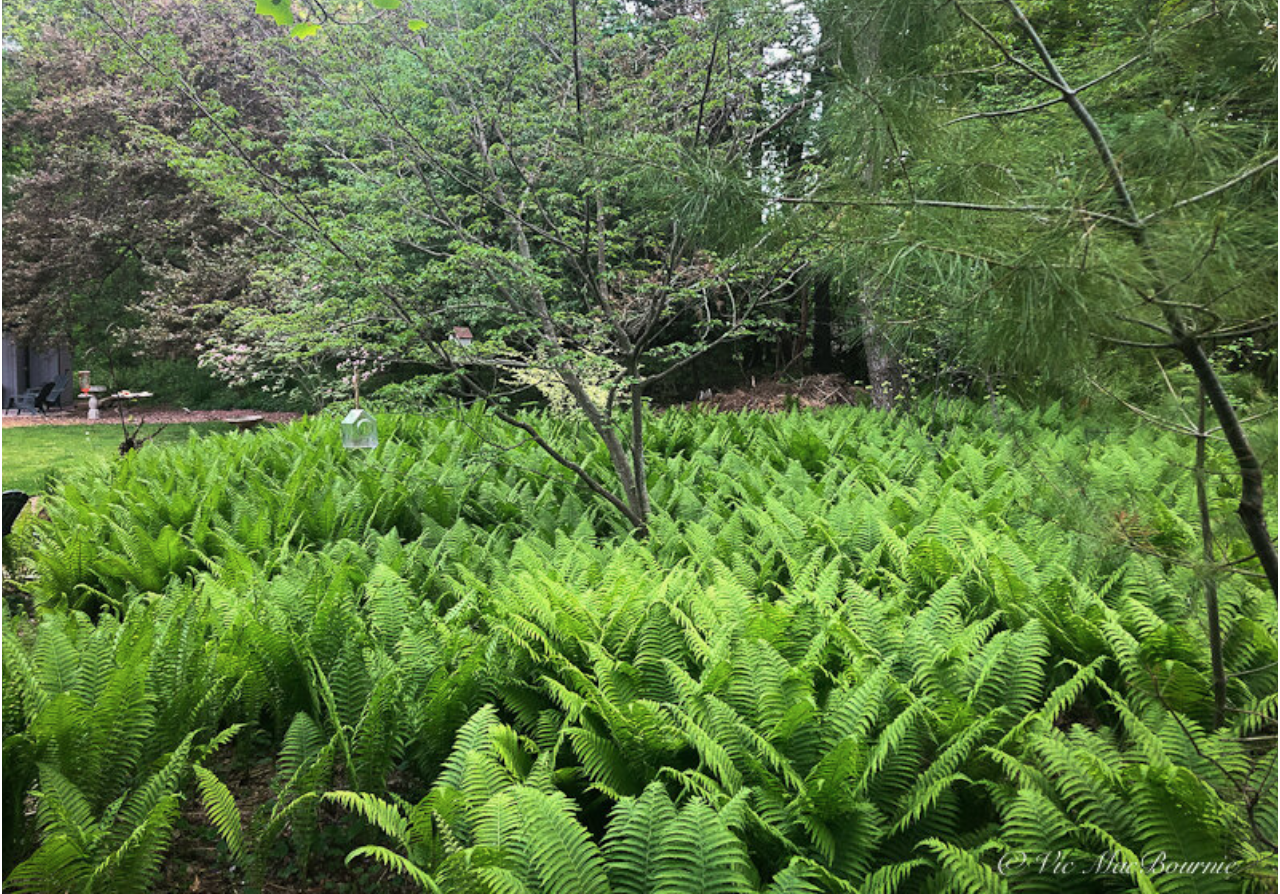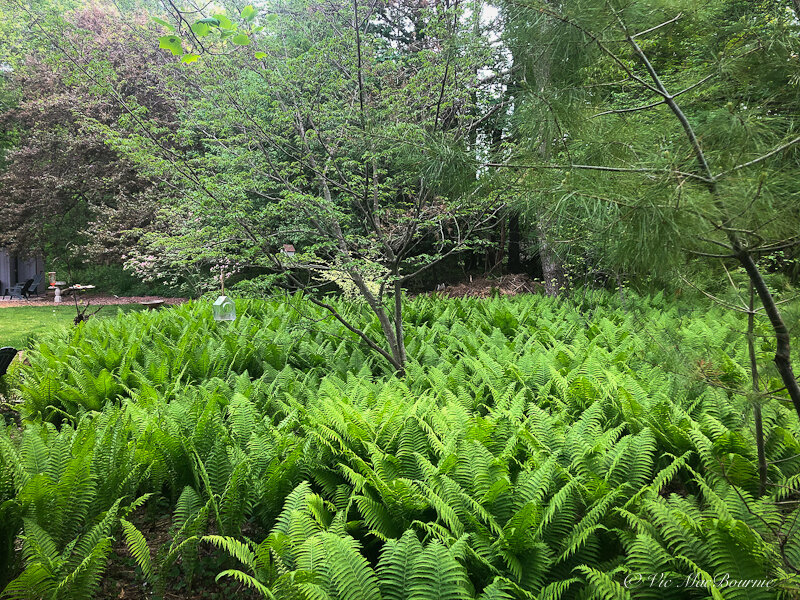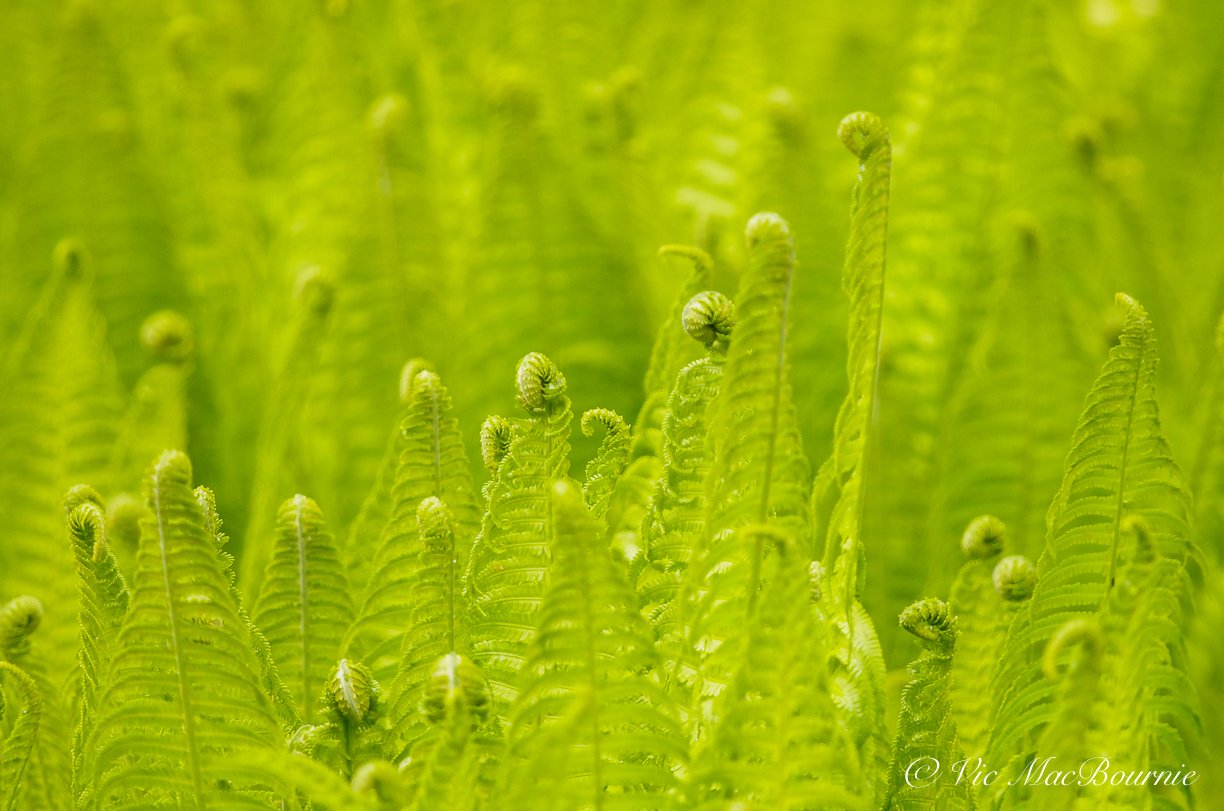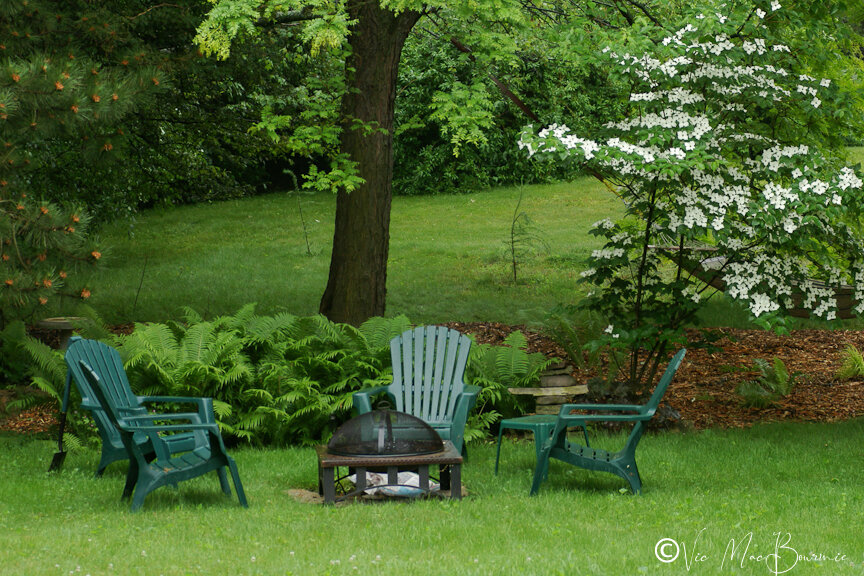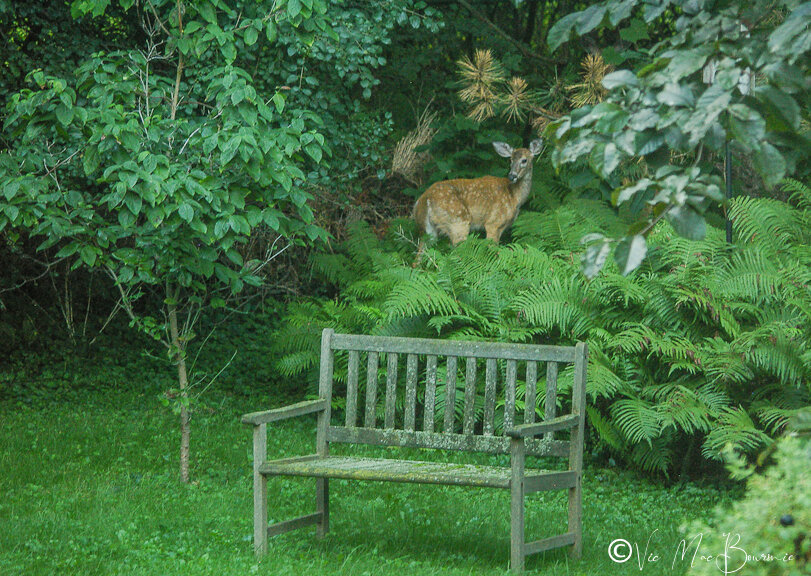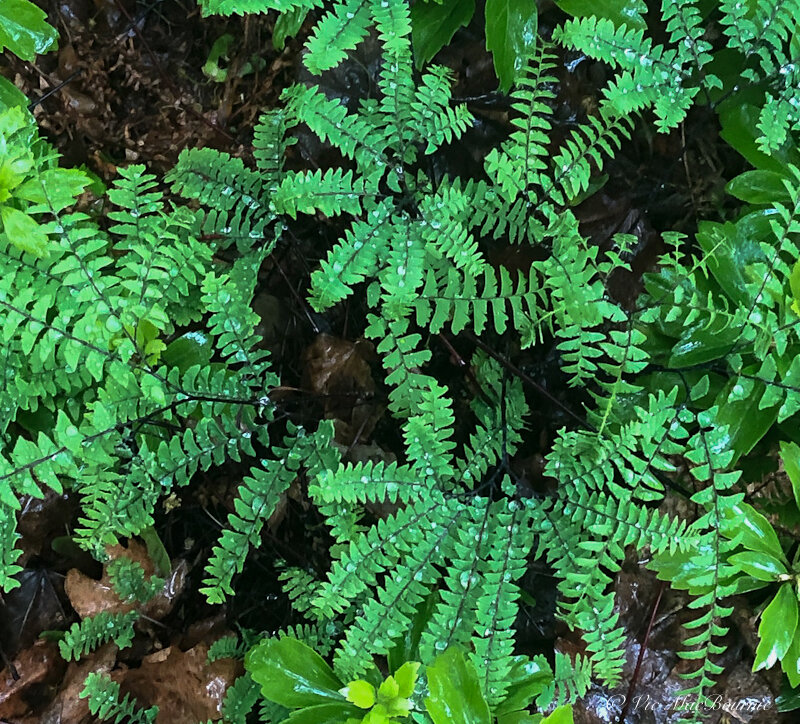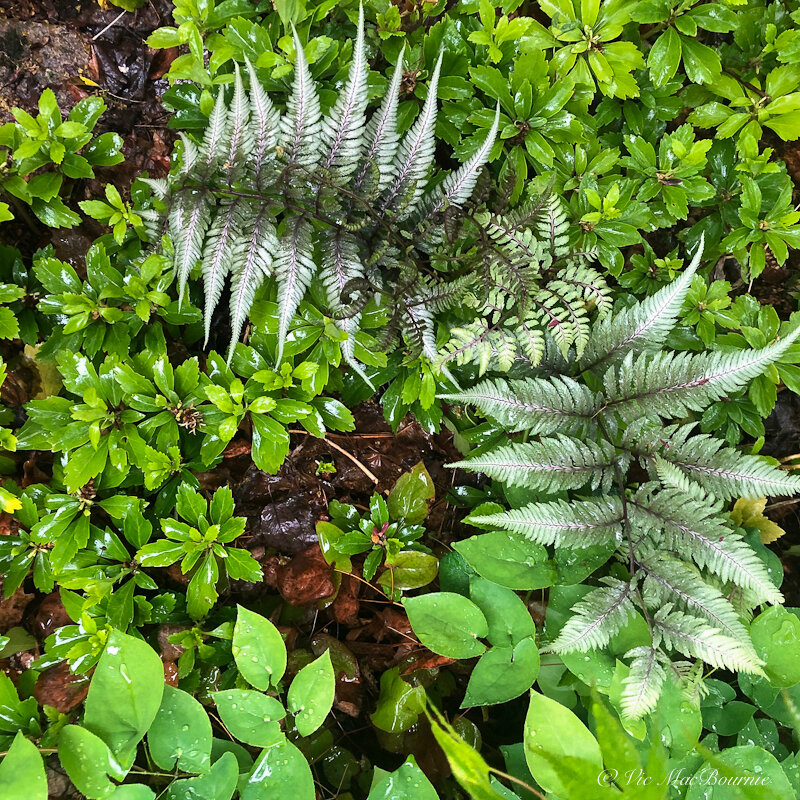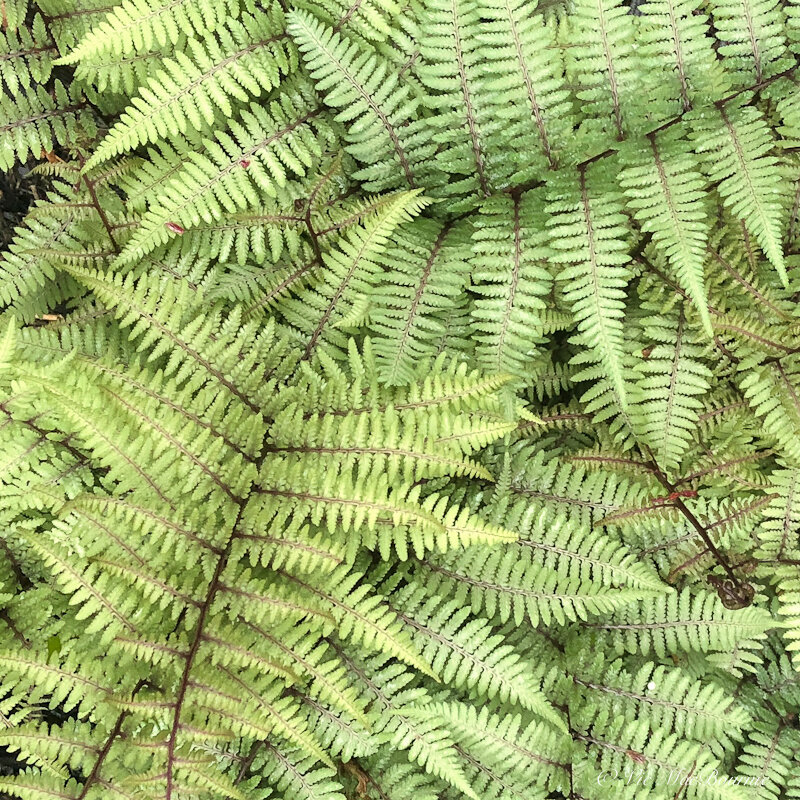How hard is it to design and create a woodland garden?
Building a Woodland garden can be a fun and rewarding experience. The key is letting go of what you may have perceived as the perfect garden and let nature do much of the work. Your focus should be in establishing layering the site with tall trees, understory trees, shrubs and ground covers. I hope this blog will help you achieve your dream.
Ideas and tips to bring backyard landscape ideas to life
It’s not easy being a woodland gardener.
I mean, how long can you sit and watch the chipmunks playing on the rocks or the birds feeding their young from the nearby birch branch. And those pesky hummingbirds buzzing around feeding from the cardinal flowers, not to mention the feeders hanging on the pole beside you.
Eventually you’ll need a break from not having to cut grass, deadhead the flowers and prune the shrubs to within an inch of their life.
So how hard is it to create a woodland garden? It’s important to know that a woodland garden design is most likely the easiest of all gardens to maintain providing you’re willing to relax a little. It’s the ultimate low-maintenance backyard landscape, but it will require some work to get it established at the front end. Plant trees, shrubs and get a ground cover established and then relax and learn to work with nature rather than against it.
It’s not all fun and games.
Add the burden of trying to satisfy our friendly chipmunk after she returns for what seems like her 100th visit to load up on peanuts.
Over in the corner of the garden, a doe rests in the tall ferns, while her two fawns romp around waiting for their day to begin.
Like I say, “this ain’t easy.”
And the noise! The birds, the bees, it’s all so overwhelming.
Nap time can’t come soon enough around here.
If this sounds good to you, it may be time to reconsider your backyard landscape design and use the information contained here on this website for backyard ideas and tips to create your low-maintenance landscape.
If you are looking for assistance, consider picking up The American Woodland Garden, by acclaimed author Rick Darke, Capturing the Spirit of the Deciduous Forest. It can be difficult to find, but is often available on the used market. Alibris, an U.S.-based used book seller, has copies of The American Woodland Garden for approximately $25 if readers are interested.
“So how hard is it to create a woodland garden? It’s important to know that a woodland garden design is most likely the easiest of all gardens to maintain providing you’re willing to relax a little. It’s the ultimate low-maintenance backyard landscape, but it will require some work to get it established at the front end. Plant trees, shrubs and get a ground cover established and then relax and learn to work with nature rather than against it. ”
If you are interested in exploring the world of shade gardening further, you might like my recent post on The Natural Shade garden.
Let the leaves fall to the ground and just leave them there over the winter.
The decaying leaves are important places for insects and pupae to overwinter. Their decomposition helps to build an earthy, humus-rich soil alive with micro-organisms.
Birds depend on the insects come spring to feed their nestlings. (Check out this post for the complete story on leaving your leaves where they fall.) (Check out this post on how to use fallen leaves to build your Woodland soil.)
The ultimate woodland wildlife garden incorporates layering. This illustration shows what birds primarily use the various zones.
Relaxing is key to building a woodland garden design
To build a Woodland garden, it’s important to be willing to let nature do its thing and not worry about every little weed (let’s just call it a wild flower shall we).
Instead of spending our days weeding, let’s, instead, ensure our Woodlands are filled with a variety of ground covers that stop weeds from taking over the garden beds.
Try a little Snow-in-Summer in a hot dry area to cover the ground with a living mulch. Not only is Snow-in-Summer a beautiful ground cover, it offers outstanding opportunities for some beautiful selective-focus photography.
If you do it right, you’ll have plenty of time to photograph the daily life of your garden and its visitors.
Where living ground covers are inappropriate, let’s use organic mulch like shredded bark, pine needles or composted leaves to cover the soil and restrict any weeds that want to poke up through the soil.
Instead of pulling weeds all summer, let’s relax with a glass wine on the patio and enjoy our feathered friends. Let’s use that time to focus on planting more native plants to attract more insects to our yards that, in turn, will bring more birds to our woodland gardens.
And those hostas that were eaten by our family of deer, let’s just rejoice in the fact we are keeping the local wildlife happy and healthy. (Click here for a gallery of the wildlife that visit our Woodland garden.)
If you can live with that, welcome to my woodland garden blog. It’s aptly named Ferns & Feathers for its abundance of both ferns and feathered friends.
If you care to join me, we’ll tackle this thing together; learn from one another’s shared knowledge and experiences. We can take some time to enjoy a discussion or two about building the woodland garden one tree at a time through layering – from the forest floor to the tips of the tallest trees.
Along the way we’ll share our top 3… top 5… top 10. (Click here for my five favourite bird items or here for my top 5 woodland garden books.
We’ll share what products work best for us, (like this Gorilla Cart or a blue tooth speaker) some time-saving tips, work-saving tips.
I’ll also be sharing garden photography tips, tricks and ideas to bring out the best images hiding in your garden. Doesn’t matter if your best camera is an i-phone, a sweet little point-and-shoot enthusiast camera model or a full-featured digital 35mm camera. I use them all to document our garden and, with a little luck, can pass on some wisdom from a hobby I’ve been enjoying most of my life.
And I’ve got some time after recently retiring from almost 40 years in the newspaper business. So, with all this time on my hands, my wife told me to find something to fill it with or else… I decided to combine two of my great loves – gardening and photography – into a fun little spot on the web for like-minded gardeners to pull up an adirondack chair and join me and Holly (our four-legged friend) to share some tall tales, our victories, failures and a decent glass of wine.
Okay, let’s get this show on the road.
Creating woodland wildlife garden is simple with this design plan
A woodland wildlife garden is the best environmental choice for garden design. Ecologically, a woodland garden using native plants will help to restore native flora and fauna in our urban and suburban areas that are being over run with non-native, exotic plants that are damaging our environment. Here is a design plan complete with a plant list so that everyone can help to save our environment one garden at a time.
Woodland wildlife garden is ideal ecological choice
For many of us, the most difficult part of creating a backyard garden is deciding on the design and the style.
In an effort to simplify the process and help to put readers on the road to success, Ferns & Feathers teamed up with garden designer extraordinaire Angela den Hoed of Soil&Ink in Carlisle, Pennsylvania to offer readers a blueprint for their own Woodland Wildlife garden design.
What’s the most ecological style of garden?
A woodland wildlife garden is one of the most ecological garden choices and one that, if more gardeners created one in their backyards, would be a giant step forward to rewild our urban and rural landscapes and create environmental green spaces that will go a long way in rejuvenating our native flora and fauna.
By following the design plan and the attached planting guide (zones 5-6) it is possible to create the Woodland Wildlife garden you may have only dreamed about. Use the plans to create the garden over several years as a DIY project, or hire professionals to create the garden for you. You may already have some of the elements in your garden or you may want to start from scratch. Either way, there is no reason not to get started on the garden of your dreams.
Angela has created an impressive Meadow garden. If you are interested in seeing how she created a meadow garden, go here.
If you are interested in exploring the world of shade gardening further, you might like my recent post on The Natural Shade garden.
For more on Angela’s outstanding work, check out her meadow garden and her five favourite plants for the meadow garden.
In addition to providing readers with this detailed landscape plan, we have written a comprehensive post on creating a Woodland/wildlife garden for a small yard. You can find this article here.
By joining our woodland garden community newsletter, you will receive a downloadable ebook with the complete design plan. To sign up for the newsletter, go to our home page here, scroll to the bottom and complete the newsletter form.
Professional woodland design using native plants
The highly detailed plan is scaled for today’s typical backyard, but can be scaled up or down depending on the size of your lot. In addition, if you have a large property, this plan can be used for a corner of your yard or an area that might already have many of the elements already in place.
Special thanks to garden designer Angela who has put together a tremendous resource for readers by providing them with the Woodland garden design. The complete, detailed design was originally unveiled in a series of newsletters in 2020, adding specific tree, shrub, flower and ground cover suggestions for a Zones 5-6 garden design.
This article presents the finished product, including the planting scheme for readers.
Angela has used a traditional woodland multi-layered approach in the design, leaving room for entertaining but also incorporating a water feature, a grassed area for children to play on as well as a separate sitting area to bring you into the garden and have an opportunity to view the garden from a different angle.
Angela recommends the use of many native plants in her final design. Native plants and trees are vital in a woodland garden not only to attract birds with seeds and berries, but by encouraging more insects and caterpillars into the garden that, in turn, provide protein for the early growth of nestlings and insect-eating birds like warblers.
It is often asked: What tree should I plant in my backyard? The answer is most often an Oak tree. To find out why the Oak tree is my tree of choice, check out my article here, about what tree you should consider first when it comes to planting your first tree.
To contact Angela or to see more of her work, please take a few moments to go to her website @ www.soilandink
The following valuable information has been provided by Garden Designer Angela den Hoed
Welcome to our woodland garden.
The plants chosen for this garden are all native, suited to Eastern North America, in growing zones 5 & 6. They are all chosen to support and attract wildlife, particularly birds.
A quick tour of the garden design
We start on a natural stone patio in the sunniest portion of the garden. Here there is ample space for entertaining, a grill, and for planters filled with plants that prefer sunnier conditions. You can choose to include lots of plants that will attract pollinators and hummingbirds, perhaps even adding a trellis to the planters for a flowering vine.
In the center of the garden is a lawn. Not everyone needs a lawn, but if you do, you have one. In the next newsletter we will give you options for alternatives to using grass in this space.
There is a bird bath located within the perennial garden next to the house. You may use a simple solar bubbler here if you like or install a larger fountain. As you walk around the garden to the right, you will follow a stepping-stone path, passing under a multi-stem tree underplanted with one solid groundcover. We have left the choice of groundcover up to you but choose just one species. This is a place for a special, interesting tree.
In the back corner you will come to a seating area. This will become a cozy place when the plants have grown up around it. If you like you may continue down a more intimate path within the woodland garden and pass by a larger water feature. This could be a waterfall, a pool, or a combination. The small path continues back around to the patio again.
A detailed plants list
Plants are listed along with the number of butterfly and moth species (caterpillars = bird food!) they support. Many other insects and pollinators are also supported by these plants.
Upper Story Tree Options (1)
Try to find a variety that won’t get too outsized for this small garden – 30-40’. These trees provide both habitat and food in the form of caterpillars and insects for birds.
Oak – Willow (Quercus phellos), Pin (Q. palustris), or Bur (Q. macrocarpa): Oak trees support the highest quantity of wildlife of any plant in the region including 519 species. Their acorns also provide food for other wildlife.
Maple – Red (Acer rubrum) or Sugar (A. saccharum): Support 293 species. It may be easier to find a maple the appropriate size for a small garden.
Understory Tree Options (3)
• Flowering Trees (2) – choose 2 of the same variety, or mix them up:
Crabapple – American/Sweet (Malus coronaria): Flowers in spring and provides fruit in the fall and throughout the winter. Supports 287 species.
Dogwood – Flowering (Cornus florida) or Pagoda (C. alternifolia): Flowers in spring and supports 124 species.
• Multi-stem Tree (1):
Plum - American (Prunus americana) or Chokecherry (P. virginiana): Plums are #2 on the list of trees in terms of the number of butterflies and moths they support (435). These will flower in the spring and provide berries for birds in the fall.
Serviceberry – Canadian Serviceberry (Amelanchier canadensis) or Allegheny Serviceberry (A. laevis): These also bloom in late spring, support 135 species and provide birds food in the form of berries in the fall.
Magnolia – Sweetbay Magnolia (Magnolia virginiana): Supports 20 species including a few that can only live on Magnolias.
Shrubs to consider
Arrowwood Viburnum (Viburnum dentatum): Spring flowers lead to blue-black berry like drupes that are an ideal fuel for bird migration. 111 species supported
Inkberry Holly (Ilex glabra) ‘Gembox’: 44 species supported
Red Osier Dogwood (Cornus sericea) – ‘Arctic Fire’: White flower, blue drupes in summer, red fall color, bright red branches in winter. Like the dogwood tree, supports 44 species
Pinxterbloom Azalea (Rhododendron periclymenoides): Pink flowers in spring, supports 53 species
Oakleaf Hydrangea (Hydrangea quercifolia) ‘Ruby Slippers’ or ‘Munchkind’: Supports 10 species.
New Jersey Tea (Ceanothus americana): White flowers in spring, supports 44 species.
Summersweet/Sweet Pepperbush (Clethra alnifolia) ‘Ruby Slippers’: Fragrant pink flowers in summer, attracts hummingbirds and pollinators.
Perennials to consider
• White Wood Aster (Aster divaricatus): White flowers late summer, supports 115 species
• Columbine (Aquilegia canadensis): Red flowers in spring, Supports 12 species.
• Cinnamon Fern (Osmunda cinnamomea): Cinnamon red new growth, supports 7 species.
• Virginia Bluebells (Mertensia virginica): Blue flowers in spring, supports 3 species.
• Early Meadow Rue (Thalictrum dioicum): Greenish yellow flowers in spring, supports 15 species.
• Short’s Aster (Symphyotrichum shortii): Blue-violet flowers in fall, supports 11 species.
• Goat’s Beard (Aruncus dioicus): Tall white flowers in May.
• Coral Bells (Heuchera villosa) ‘Autumn Bride’: White flowers late summer.
• Tall Thimbleweed (Anemone virginiana): White flowers in summer, supports 2 species.
• Foamflower (Tiarella cordifolia): White or pink flowers in May.
Ground covers to consider
Choose one of the varieties below for the groundcover under the multi-stem tree
• Dwarf Crested Iris (Iris cristata): Blue-violet flowers in April, supports 13 species.
• Wild Ginger (Asarum canadense): Burgundy flowers in spring at the ground.
• Wild Blue Phlox (Phlox divaricate): Blue flowers in spring, supports 3 species.
• Wild Geranium (Geranium maculatum): white, pink, or purple flowers in spring, supports 27 species.
If you like what you see here but would like more guidance consider using the on-line services Angela offers at Soil&Ink. She can create specific plans for your backyard or offer plants that might be more suitable for your particular zone or style you are trying to achieve. Contact her through her website @ Soil&ink
Other important links for Woodland/Wildlife gardeners
• Chelsea Award winning garden designer Mary Reynolds. See my earlier post about her book here. Go to Mary’s popular website here where she promotes land stewards to create natural Arks to help protect and restore our natural environments.
• Earlier post on Garden mulch: organic vs non-organic. Link here to my earlier post.
• Earlier post to my favourite ground covers for the woodland garden. Link here to my earlier post
• Earlier post on using a local woodland as inspiration for the woodland garden design. Link here to my earlier post.
As an affiliate marketer with Amazon or other marketing companies, I earn money from qualifying purchases.
How to create a woodland fern garden (in big and small yards)
Even today's smaller backyards have room to create a native fern garden. Whether you have a small or large backyard, a fern garden will bring a sense of solitude to your woodland wildlife garden. These garden tips and ideas will help beginners and experienced gardeners plan, design and create the perfect fern garden in a corner of their yard to attract birds and other backyard wildlife.
How to use a variety of ferns to create a tranquil garden
It all started with a few ferns from a friend at work and a warning about how fast they can take over.
Today those ferns have grown into a massive backyard fern glen and I have tapped into the huge variety of ferns that are available to gardeners. The number of fern varieties is endless, from tiny ones that go unnoticed in the landscape to huge tree ferns that grow in more temperate climates.
(More on the variety of ferns available lower down in this post.)
Back to the ostrich ferns given to me by a co-worker. Knowing that I had a large expanse of grass on one side of our pie-shaped lot that could use a nice little garden of wildflowers, ferns and shrubs, I went to work.
That was maybe 15 years ago.
Little did I know then that this little garden would, in relatively short order, become the focal point of our woodland wildlife garden, providing endless joy in spring and summer not only for me, but for the myriad of wildlife that can easily get lost in its hundreds, heck maybe thousands, of massive ostrich ferns.
If you are interested in exploring the world of shade gardening further, you might like my recent post on The Natural Shade garden.
If you want even more information on ferns, you might want to explore the book The Plant Lovers Guide to Ferns.
Why create a Fern Garden?
The fern garden has become a favourite place for deer to hide their youngsters during hot summer days. I know the resident fox has used it as a secret roadway into the main garden emerging, as she often does, from the middle of the fern glen. I have come across shedded snake skins among the spent ferns in the fall and watched countless chipmunks scamper into the cool surroundings of the ferns on hot days. It’s a home for toads and salamanders seeking deep shade during the heat of the day and creates the perfect backdrop for the under story trees and shrubs that grow up through the ferns in our woodland wildlife garden.
One day I even decided to get down low and crawl through the maze of ferns to get the same view as the animals that call it home.
To say it’s a whole new world in there is a huge understatement, and I can only imagine the young fawns thinking they are giants in a miniature, prehistoric forest.
If you are looking to add plants to your garden this year, consider planting seeds to help you fill out bare spots in your garden beds. Use this link to get 20 per cent off your next seed order from Burpee Seeds.
How do ferns help wildlife?
Anne Owen, an Audubon at Home Ambassador with the Loudoun Wildlife Conservancy, in her article Native Ferns Have a Place in Our Plantings for Wildlife writes that “From a wildlife point of view, ferns can give structure that provides foraging space and shelter for ground-feeding birds, while other critters, for example frogs and turtles, like to hide in them. Ferns are generally resistant to browsing by rabbits.” (For the complete post go here.)
Oh, and let’s not forget the best reason for many of us to grow a fern garden: Deer leave ferns alone. Anything deer prefer to leave OFF their dinner diets is definitely worth growing in a woodland garden.
We are blessed with a good-sized property and are able to set aside a large portion of it for the establishment of a fern glen. I realize many gardeners either don’t have the space, or don’t want to donate that amount of space to create such a huge expanse of ferns in their backyard.
That’s no problem. A more compact fern garden in the understory can be just as rewarding.
How to create a fern garden in smaller yard
Obviously, in a smaller backyard the fern garden could be downsized to better fit into the proportions of the garden.
The quiet serenity that a fern garden can create is certainly incentive enough to begin planning for an area in the garden you can retreat to on hot summer days.
Building the right soil for ferns
If you can start with a rich, moist, earthy soil with plenty of decayed or decaying material in it, you are off to a good start. You can, however, build this soil over time by using the fern garden as a destination for all those leaves you collect in the fall and spring. Over time, the soil will build up an earthy layer of forest duff, perfect for growing woodland ferns.
Our fern garden is the primary dumping ground for most of the fall leaves I pick up from the front yard. Each year it gets 5-10 bags of leaves dumped in various spots throughout the fern garden. In some areas the leaves are several inches thick, but that doesn’t stop the ostrich fern fiddleheads from popping up through them every spring.
I originally used the newspaper layering technique to give our fern garden a good start. My neighbour had at least ten bags of leaves that he had not put out by the curb in the fall. By the time spring rolled around they were a soggy mess of paper bags and partially decomposed leaves.
Perfect to give the fern garden a good start.
He happily accepted my request to take them off his hands and the project began.
A thick layering of newspapers to block the light and ensure a quick end to the grass, followed by a bags of fresh soil, ten bags of partially composted leaves and a handful (I think somewhere in the neighbourhood of 10-15 ferns) all nicely covered by several bags of cedar mulch, and the project was complete.
Or so I thought. Since then, the ferns have spread out from all directions multiplying each year to form the massive fern garden incorporating hundreds if not thousands of ferns.
How to use ferns as a ground cover
In the beginning days, the compact fern garden, (maybe 6-feet by 12 feet) centred around a young Cornus Kousa dogwood that I had planted that same year.
Today, 20 years later, that same Kousa dogwood is a spectacular mature specimen that stretches two-, maybe three-storeys high and probably 16-feet wide. Most years it puts on a show of creamy-white blooms that is simply breathtaking and the huge, red, strawberry-like fruit that follows are a favourite of local wildlife. (Check out my earlier post on six great dogwoods for the Woodland garden here.)
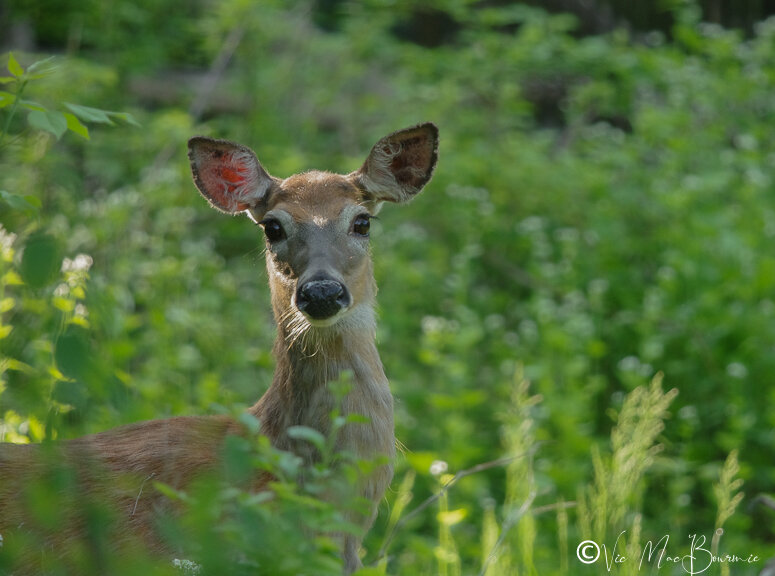
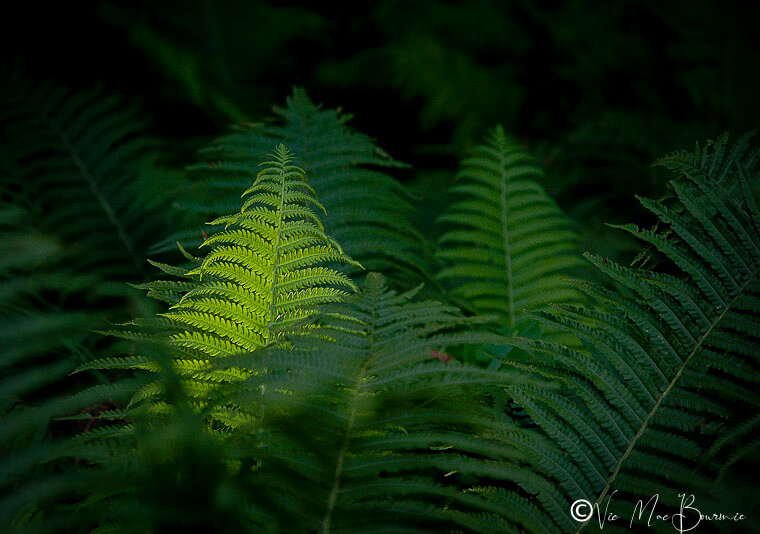
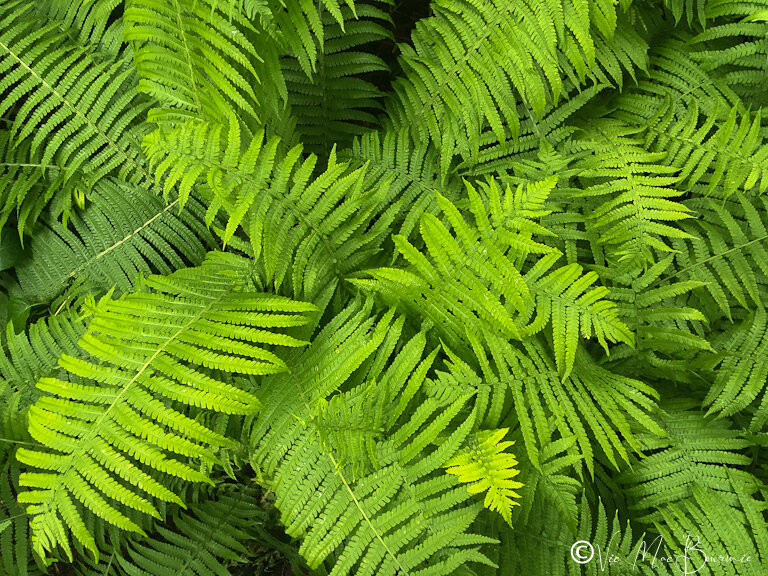

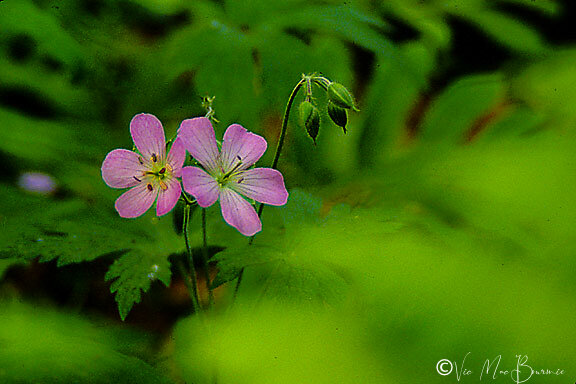
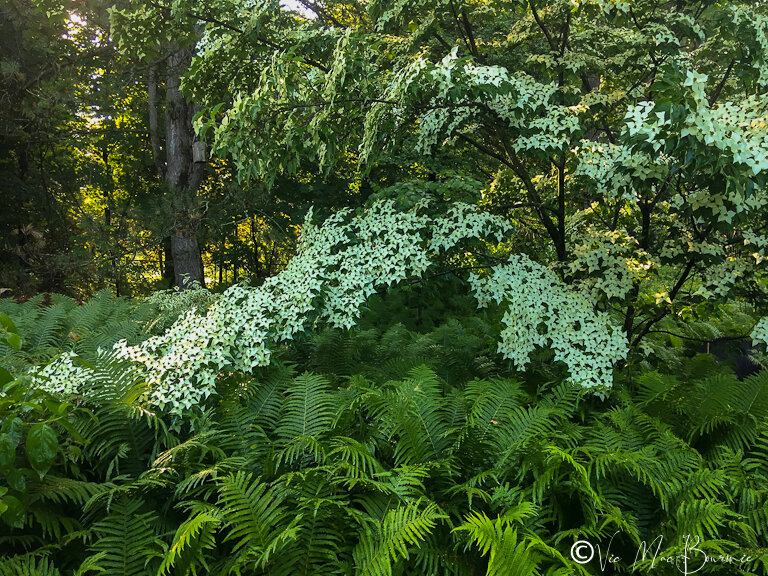
A quick note: In a smaller garden the Kousa dogwood can be kept pruned to some degree to keep it more compact. I am a big believer that, for the most part, trees should be allowed to grow into their natural shape. As a result, the Kousa dogwood, not unlike most dogwoods, takes on a very horizontal branching shape that I think gives it a Japanese-style look.
By simply taking a scaled-down approach in your smaller garden you can create a similar effect.
A few dozen of the more compact-style ferns scattered around a couple of your favourite understory trees such as a native flowering dogwood, or pagoda dogwood (see earlier post on three great Carolinian zone under story trees), or a native redbud tree (See earlier Redbud tree post here) can evoke that same peaceful feeling on a smaller scale and provide you with spring blooms and berries.
How ferns spread in the garden
It’s important to note that ferns have two basic forms of growth: creeping (which includes our ostrich ferns) and crown-forming.
The creeping forms can spread through the garden at times aggressively from trailing rhizomes or stolons.
The crown forming ferns (such as maidenhair ferns) grow much in the same way as traditional perenials grow by expanding from the centre.
These ferns grow from upright rhizomes and carry their fronds in a tight circle.
These are important points when considering your choice of ferns and how much you want the garden to grow or the work you are willing to tackle to keep it contained.
Fern varieties to consider in a smaller garden
Ferns are available in such a variety of shapes and sizes, colours and textures that the selection is almost endless.
Consider using a combination of native and non-native ferns to create your fern glen. The following is a list of several native ferns that deserve top consideration in your garden. We use many of these ferns in our front woodland garden where there is less competition from the larger Ostrich ferns that dominate the back fern garden.
Maidenhair ferns: A hardy, yet delicate and graceful fern that is at home in any woodland setting with its charming whorl of light, gray-green feathery foliage that spreads in clump form and is at home in a range of soil conditions including growing near or even on rocks and areas with acidic soil. There are a number of maidenhair species (Northern, Southern, Rosy, Western and Silver dollar) to consider depending on the zone where you garden.
Wood Fern: (Dryopteris marginalis) This non-spreading fern sports graceful, arching gray-green fronds that form a vase-shaped clump. Expect about 24 inches in height and similar spread in this long-lived plant with dense foliage extending right to the ground. Enjoys part shade to full shade in a medium to wet organic loam and grows to about 2 feet.
Sensitive Fern: (Onoclea sensibilis) this interesting looking fern with its tender leaflets that close to your touch (hence the name) is readily propagated by spores and grows in large colonies in the wild. This light green fern is considered short-lived (10 years) but is quick to naturalize in woodland gardens and boggy areas with a definite preference for acidic soils.
Autumn fern: (Dryopteris erythrosora) a semi-evergreen fern (zone 5-9) with year-round interest. It’s attractive glossy ferny compound leaves emerge coral-pink in spring turning green with prominent coppery-bronze tips for the remainder of the year.
Growing to about 18 inches tall at maturity with a similar size spread, the Autumn fern is one of the few ferns that performs well in both full sun and full shade.
It prefers average to wet conditions and can even be grown in very wet areas tolerating some standing water. Grow it in rich, acidic soils in mass plantings, rock/alpine gardens or naturalized in a woodland garden.
Non-native ferns worth considering
While it’s always best to use native plants, it’s hard not to include a few non-native ferns for the fern garden, especially the Japanese painted fern with it’s delicate silvery fronds that really is a showstopper in a shady area.
Japanese painted fern: Athyrium nipponicum ‘Pictum’ and its many hybrids (zones 4-8) shines in the woodland with its silvery, purple and burgundy foliage. Japanese painted ferns are among the best silver-leaved plants for the garden with the added bonus of creating a dense, fine-texture with their interesting colour patterns that look almost hand-painted.
Use them in mass planting, as a dense ground cover or naturalized in the woodland garden.
The main stems are an eye-catching burgundy colour that spills out into the silvery-gray fronds.
Like most ferns, they prefer a shady location, but because of its silvery fronds, the Japanese painted ferns can handle more sun than many other ferns.
Expect growth of about 18 inches in height with a spread of 24 inches. It’s a slow grower but can live up to 15 years in our cold climates.
Ghost fern: Athrium ‘Ghost’ is another fern to consider, and one that is actually related to the Japanese painted fern. This larger fern, hardy in zones 3-8, can grow to about 2 feet tall and is a combination of the best qualities of a Japanese painted and a Lady fern.
The fronds of the ghost fern are stunning in a shaded location with fronds that give off an almost frosty-white appearance to their rigidly upright look. It does best in partial shade with a moist, neutral to moderately acidic PH soil.
A little sun helps to bring out its best colouring and it can survive in drier soil than many other ferns.
Lady Fern: (Atthyrium felix-femina) is a favourite for those with sandy loam or clay loam where this tough fern will grow quite willingly to about 3 feet in height.
Ground covers to highlight your fern collection
Ferns can work both as a ground cover or as the focal point in the fern garden.
In my fern garden they work more as a very tall ground cover and form the backdrop for the dogwood, serviceberries, redbud, white pine, spruce trees trees and shrubs that grow up through them.
In a smaller garden, consider using the ferns as your focal points with more delicate and lower-growing ground covers.
Natural moss is the perfect companion for a variety of ferns preferring the same slightly acid soil that many ferns enjoy.
Perennial moss-like ground covers such as Irish and Scotch moss are excellent substitutes as well as the many thyme varieties. (For a closer look at some of my favourite moss-like ground covers go here.)
Other plants to consider growing alongside ferns include hostas that, although a non-native, work extremely well with ferns.
The hostas’ bold foliage is set off nicely by the delicate foliage of most ferns. Just pay attention to the ultimate size of both the hostas and the ferns. The larger ferns can quickly bury the smaller hostas. Choose a hosta large enough to compete happily with the chosen ferns.
In her inspirational book, Foliage and Garden Design, Canadian gardening author Marjorie Harris describes her love for combining ferns and hostas in the garden.
“Hostas and ferns are two families of plants that are so versatile you can work them in with shrubs and under trees, providing you add lots of humus and water regularly if it’s dry shade. These two perennials are among my favourites and I’ve tried to incorporate plenty of them.”
Other plants that work well with ferns include: ornamental grasses, spring ephemerals like trilliums, dog-tooth violet and columbine.
Spring bulbs can also be grown to add a little colour early in the season before the ferns have fully emerged.
Black-eyed Susans are also a showstopper growing in drifts through the ferns.
In our front garden, I have a lovely group of columbine surrounded by maidenhair ferns growing next to a large mossy limestone boulder. The combination is a nice late spring vignette that catches my attention every time I pass by.
Some final thoughts on ferns
I’m not sure what it is about ferns that always catch my attention, whether they are growing wild in the woodlands, in the spring garden as they unfurl their delicate fronds, or in the garden centre where I am confronted by a host of must-have specimens.
At first glance they appear to have very little to offer. Maybe this is the reason ferns are sometimes overlooked by gardeners, especially beginner gardeners often focused on bright-coloured and showy flowers or similarly-coloured foliage.
Ferns will have none of that.
It’s all about shades of green, texture and a rugged hardiness when it comes to ferns. Sure, there are the silvery fronds of the Japanese painted fern, but they just can’t compete with those massive dinner-plate-sized dahlias, the bright reds of big-box geraniums or even the neon-like colours of today’s coleus.
Instead, ferns take a backstage and work hard to create a quiet, cool resting place for our eyes and our minds.
However, even in a fern garden, there is alsway room for a ‘pop’ of colour.
In fact, it is the ferns that will take the pop of colour to a whole other level.
Try adding a hanging basket or a raised container of brightly-coloured fuchsia to your fern garden to create a simple focal point and maybe create a natural area for your hummingbirds or butterflies to visit reguarly.
The hummers will enjoy the cool, quiet of the fern garden along with the added benefit of a free meal.
Be sure to include a perch either natural or store bought for the hummingbirds to rest above the ferns
Nearby, include a bench for you to sit and enjoy the solitude of the fern garden with the occasional visit from the hummingbirds.
Ferns enjoy a long history
If time is any indicator, there is little doubt that the fern garden will be a recipe for long-term success.
Ferns, in fact, can be traced back through fossil records to a time more than 100 million years before dinosaurs walked the earth. Ferns actually grew before any flowering plants even existed on earth. Today there are thousands of species of ferns, from the tiniest that grow just inches off the ground to massive tree ferns.
Thinking back, maybe there was something to that day I decided to crawl through our fern garden to get the feel for what animals experience on their daily jaunts through the ferns.
Maybe just a reminder that our gardens are not that far from those prehistoric times when dinosaurs roamed the earth.
And, a reminder that the ferns are among the few living things left of those times.
As an affiliate marketer with Amazon or other marketing companies, I earn money from qualifying purchases.

